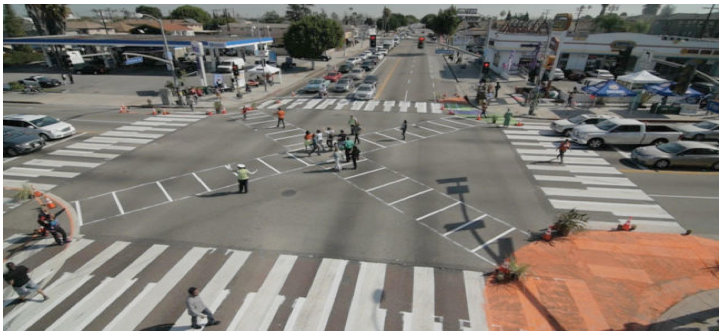CommentsURBAN UPLIFT-Fifteen percent of the landmass of Los Angeles is streets and sidewalks. These 7,500 centerline miles of roads constitute the single largest physical element under city control, according to Lilly O’Brien, program manager of the Great Streets initiative -- a political organization staffed by trained urban planners housed in Mayor Eric Garcetti’s office.
Great Streets has been working with city councilmembers, city departments like the Los Angeles Department of Transportation (LADOT), and nonprofit design organizations to make better use of existing city resources and infrastructure while simultaneously creating urban corridors that reflect --and hopefully economically engage -- the people who live there. The initiative ties into a national and even global push to pedestrianize underutilized swaths of the urban fabric. In design terms, the 15 streets the project has undertaken so far largely demonstrate this blend of infrastructural alignment and local identity through sidewalk installations and pop-up play spaces.
For one day, nonprofit organization Street Beats (photo above, courtesy Street Beats) transformed the intersection of Crenshaw and Florence into a musical instrument by using bump-outs to install DJs at each corner and fashioning scramble crosswalks to look like a giant urban keyboard. Pedestrians could engage in light-pole-mounted-speaker beat battles using iPads.
Meanwhile, on Reseda Boulevard in the San Fernando Valley, LA-Más attempted to transform the car-oriented environment of the sidewalk into a living room by designing the installed furniture in a late-midcentury modernist style and combining it with a painted flagstone paving pattern. (Photo left, courtesy Stacey Rigley/LA-Más.) As Lilly O’Brien said, “these are designed to be places that could both support a communal space and a local economy.”
“Our installations weren’t supposed to blend into the fabric; they were supposed to live in the in-between of the sidewalk, between what’s legal and illegal, between what’s private and public,” architect Elizabeth Timme, the co-executive director and cofounder at LA-Más said. According to Timme, her boundary-blurring work made it clear that the street was a pedestrian space, not a vehicular space, while also creating a far more accessible and welcoming area.
Kounkuey Design Initiative has been working on a pilot “Play Streets” program for the initiative that closes off thoroughfares in South LA to vehicles and then introduces varying amounts of infrastructure to see “how play gets activated,” cofounder and executive director Chelina Odbert said.
She’s discovering that regardless of the amount of equipment introduced into the environment, “people will play no matter what; closing down the street does the trick tangentially.” After securing the participation of LADOT and the Great Streets initiative, Odbert enlisted the help of “play experts” (i.e. kids) to develop the initial design concept into a workable reality, introducing everything from Hula-Hoops to temporary slides on reclaimed asphalt. The pilot program will run for one year, and depending on its results, may effect more permanent, citywide changes.
This potential for broader urban change is in keeping with the scope of Mayor Garcetti’s original plan. As he told AN via email, “I launched the Great Streets initiative to energize public spaces, provide economic revitalization, increase public safety, enhance local culture, and support great neighborhoods. We are changing the culture around how we use our streets by partnering with urban designers on community-level improvements that appear hyperlocal but reverberate around our city.”
The ongoing initiative will continue to develop and apply its findings to streets throughout Los Angeles.
(Julia Ingalls is a writer for the Architect’s Newspaper. This piece originated at archpaper.com. Prepped for CityWatch by Linda Abrams.
Sidebar
Our mission is to promote and facilitate civic engagement and neighborhood empowerment, and to hold area government and its politicians accountable.

 CityWatch Los Angeles
Politics. Perspective. Participation.
CityWatch Los Angeles
Politics. Perspective. Participation.
12
Fri, Dec













